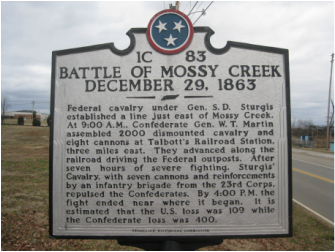
During their service in the American Civil War the 18th Indiana not only dished out plenty of severe firepower, they held their ground and took a few lumps themselves. The following, described by Cpl John Rippetoe as "The hottest work we ever had as a battery", is taken from Yankee Artillerymen and describes actions at the Battle of Mossy Creek:
When the Confederates continued to threaten to come around the flank, the First East Tennessee, mounted and the Second Michigan, on foot, charged and broke the Rebel line, temporarily drawing the artillery fire away from Lilly's battery. The charge, which captured twenty-five prisoners, ended the Confederate plans to encircle the left.
After the return of the cavalrymen to the line, the Rebel batteries resumed their duel with Lilly, and "their shells burst all around us in a perfect shower we had no time to dodge. The boys stood up in that terrible storm of death without a falter. Hits were made by both sides." Henry Campbell related that Corporal John Corbinwas leaning over sighting his gun, and Private Ezra Lloyd was bent over managing the trail when an enemy shell hit the left trunnion of the gun. The shell glanced up into Corbin's face and exploded, "scattering his face and brains in every direction, taking all his head and neck away down to his shoulders. After exploding, a piece struck Lloyd in the top of the head and carried his brains and the entire back part of his head and neck away."
The gun crew was stunned by the tragedy; but Lieutenant Joseph A. Scott, directing the fire of this and Sergeant Crouse's gun, ordered Private Albert Allen to take over Corbin's duties. The crew quickly put the gun back into action and continued to work it over the bodies of their fallen comrades.
Confederate shells continued to land among Lilly's artillerymen, with one exploding near James Dodd and a piece of it taking off the calf of one leg. John Runey had his left arm shattered by a shell; and Huey Sprague, a detail from the cavalry, was wounded in the ankle by a piece of a shell. James Wilcoxen, another detail, was stunned by a shell exploding over him and hurt when a horse fell on him. Henry Campbell had a narrow escape when a shell cut off a sapling to which he was tying his horse and the captain's.
It should be noted that of the 156 men who joined Lilly's Battery, 32 of them would die from wounds received or disease and 26 were discharged for disability.
These were truly heroic men worthy of being remembered!
When the Confederates continued to threaten to come around the flank, the First East Tennessee, mounted and the Second Michigan, on foot, charged and broke the Rebel line, temporarily drawing the artillery fire away from Lilly's battery. The charge, which captured twenty-five prisoners, ended the Confederate plans to encircle the left.
After the return of the cavalrymen to the line, the Rebel batteries resumed their duel with Lilly, and "their shells burst all around us in a perfect shower we had no time to dodge. The boys stood up in that terrible storm of death without a falter. Hits were made by both sides." Henry Campbell related that Corporal John Corbinwas leaning over sighting his gun, and Private Ezra Lloyd was bent over managing the trail when an enemy shell hit the left trunnion of the gun. The shell glanced up into Corbin's face and exploded, "scattering his face and brains in every direction, taking all his head and neck away down to his shoulders. After exploding, a piece struck Lloyd in the top of the head and carried his brains and the entire back part of his head and neck away."
The gun crew was stunned by the tragedy; but Lieutenant Joseph A. Scott, directing the fire of this and Sergeant Crouse's gun, ordered Private Albert Allen to take over Corbin's duties. The crew quickly put the gun back into action and continued to work it over the bodies of their fallen comrades.
Confederate shells continued to land among Lilly's artillerymen, with one exploding near James Dodd and a piece of it taking off the calf of one leg. John Runey had his left arm shattered by a shell; and Huey Sprague, a detail from the cavalry, was wounded in the ankle by a piece of a shell. James Wilcoxen, another detail, was stunned by a shell exploding over him and hurt when a horse fell on him. Henry Campbell had a narrow escape when a shell cut off a sapling to which he was tying his horse and the captain's.
It should be noted that of the 156 men who joined Lilly's Battery, 32 of them would die from wounds received or disease and 26 were discharged for disability.
These were truly heroic men worthy of being remembered!

 RSS Feed
RSS Feed
